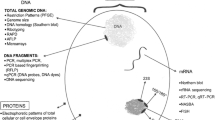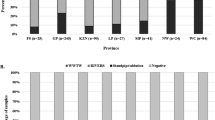Abstract
Norovirus (NoV) is responsible for an estimated 90 % of all epidemic nonbacterial outbreaks of gastroenteritis worldwide. Waterborne outbreaks of NoV are commonly reported. A novel GII.17 NoV strain emerged as a major cause of gastroenteritis outbreaks in China during the winter of 2014/2015. During this time, an outbreak of gastroenteritis occurred at a hotel in a ski park in Hebei Province, China. Epidemiological investigations indicated that one water well, which had only recently been in use, was the probable source. GII.17 NoV was detected by real-time reverse-transcription polymerase chain reaction from samples taken from cases, from concentrated water samples from water well, and from the nearby sewage settling tank. Nucleotide sequences of NoV extracted from clinical and water specimens were genetically identical and had 99 % homology with Beijing/CHN/2015. All epidemiological data indicated that GII.17 NoV was responsible for this outbreak. This is the first reported laboratory-confirmed waterborne outbreak caused by GII.17 NoV genotype in China. Strengthening management of well drinking water and systematica monitoring of NoV is essential for preventing future outbreaks.



Similar content being viewed by others
References
Bull, R. A., Tu, E. T., McIver, C. J., Rawlinson, W. D., & White, P. A. (2006). Emergence of a new norovirus genotype II.4 variant associated with global outbreaks of gastroenteritis. Journal of Clinical Microbiology, 44, 327–333.
da Silva, A. K., Le Saux, J. C., Parnaudeau, S., Pommepuy, M., Elimelech, M., & Le Guyader, F. S. (2007). Evaluation of removal of noroviruses during wastewater treatment, using real-time reverse transcription-PCR: different behaviors of genogroups I and II. Applied and Environment Microbiology, 73, 7891–7897.
de Graaf, M., van Beek, J., Vennema, H., et al. (2015). Emergence of a novel GII.17 norovirus—End of the GII.4 era? Euro Surveillance 20.
Emergence of new norovirus strain. (2013). GII.4 Sydney-United States, 2012. MMWR. Morbidity and Mortality Weekly Report, 62, 55.
Flannery, J., Keaveney, S., Rajko-Nenow, P., O’Flaherty, V., & Dore, W. (2012). Concentration of norovirus during wastewater treatment and its impact on oyster contamination. Applied and Environment Microbiology, 78, 3400–3406.
Gao, Z., Li, X., Yan, H., et al. (2015). Human calicivirus occurrence among outpatients with diarrhea in Beijing, China, between April 2011 and March 2013. Journal of Medical Virology, 87, 2040–2047.
Jiang, X., Huang, P. W., Zhong, W. M., Farkas, T., Cubitt, D. W., & Matson, D. O. (1999). Design and evaluation of a primer pair that detects both Norwalk- and Sapporo-like caliciviruses by RT-PCR. Journal of Virological Methods, 83, 145–154.
Kiulia, N. M., Mans, J., Mwenda, J. M., & Taylor, M. B. (2014) Norovirus GII.17 predominates in selected surface water sources in Kenya. Food and Environmental Virology.
Kroneman, A., Vennema, H., Deforche, K., et al. (2011). An automated genotyping tool for enteroviruses and noroviruses. Journal of Clinical Virology, 51, 121–125.
Kroneman, A., Verhoef, L., Harris, J., et al. (2008). Analysis of integrated virological and epidemiological reports of norovirus outbreaks collected within the Foodborne Viruses in Europe network from 1 July 2001 to 30 June 2006. Journal of Clinical Microbiology, 46, 2959–2965.
Lee, H., Kim, M., Lee, J. E., et al. (2011). Investigation of norovirus occurrence in groundwater in metropolitan Seoul, Korea. Science of the Total Environment, 409, 2078–2084.
Li, Y., Guo, H., Xu, Z., et al. (2013). An outbreak of norovirus gastroenteritis associated with a secondary water supply system in a factory in south China. BMC Public Health, 13, 283.
Lindesmith, L., Moe, C., Marionneau, S., et al. (2003). Human susceptibility and resistance to Norwalk virus infection. Nature Medicine, 9, 548–553.
Locas, A., Barthe, C., Barbeau, B., Carriere, A., & Payment, P. (2007). Virus occurrence in municipal groundwater sources in Quebec, Canada. Canadian Journal of Microbiology, 53, 688–694.
Lu, J., Sun, L., Fang, L., et al. (2015). Gastroenteritis outbreaks caused by norovirus GII.17, Guangdong Province, China, 2014–2015. Emerging Infectious Diseases, 21, 1240–1242.
Matsuura, K., Hasegawa, S., Nakayama, T., Morita, O., & Uetake, H. (1984). Viral pollution of the rivers in Toyama City. Microbiology and Immunology, 28, 575–588.
Matsuura, K., Ishikura, M., Yoshida, H., et al. (2000). Assessment of poliovirus eradication in Japan: genomic analysis of polioviruses isolated from river water and sewage in toyama prefecture. Applied and Environment Microbiology, 66, 5087–5091.
Matthews, J. E., Dickey, B. W., Miller, R. D., et al. (2012). The epidemiology of published norovirus outbreaks: A review of risk factors associated with attack rate and genogroup. Epidemiology and Infection, 140, 1161–1172.
Maunula, L., Miettinen, I. T., & von Bonsdorff, C. H. (2005). Norovirus outbreaks from drinking water. Emerging Infectious Diseases, 11, 1716–1721.
Nygard, K., Torven, M., Ancker, C., et al. (2003). Emerging genotype (GGIIb) of norovirus in drinking water, Sweden. Emerging Infectious Diseases, 9, 1548–1552.
Vega, E., Barclay, L., Gregoricus, N., Shirley, S. H., Lee, D., & Vinje, J. (2014). Genotypic and epidemiologic trends of norovirus outbreaks in the United States, 2009 to 2013. Journal of Clinical Microbiology, 52, 147–155.
Vinje, J. (2015). Advances in laboratory methods for detection and typing of norovirus. Journal of Clinical Microbiology, 53, 373–381.
Zhou, X., Li, H., Sun, L., et al. (2012). Epidemiological and molecular analysis of a waterborne outbreak of norovirus GII.4. Epidemiology and Infection, 140, 2282–2289.
Zhou, N., Zhang, H., Lin, X., et al. (2015). A waterborne norovirus gastroenteritis outbreak in a school, eastern China. Epidemiology & Infection 1–8.
Acknowledgments
We thank all the staff members of the hotel who helped with this study.
Author information
Authors and Affiliations
Corresponding authors
Ethics declarations
Conflict of Interest
The authors declare that they have no competing interests.
Additional information
Meng Qin and Xiao-Gen dong contributed equally to the manuscript.
Rights and permissions
About this article
Cite this article
Qin, M., Dong, XG., Jing, YY. et al. A Waterborne Gastroenteritis Outbreak Caused by Norovirus GII.17 in a Hotel, Hebei, China, December 2014. Food Environ Virol 8, 180–186 (2016). https://doi.org/10.1007/s12560-016-9237-5
Received:
Accepted:
Published:
Issue Date:
DOI: https://doi.org/10.1007/s12560-016-9237-5




